Identifying Common Soybean Disease During Vegetative Growth (Northern Regions)
August 25, 2023
During the growing season, soybean may develop bacterial, fungal, and viral diseases, or the plants may be damaged by nematode infestations. The development of these diseases depends on several factors and the interactions between those factors, including the environmental and agronomic conditions. Disease development is greatly influenced by the amount of rainfall (or lack thereof), seasonal temperatures, and timing of infection. Soybean products’ genetic tolerance, or susceptibility, can also influence the development of diseases. Knowing the tolerance levels of soybean products can help determine if a disease could become economically damaging. Finally, for some diseases, while infection may occur early in the growing season the identifiable effects will not appear until just prior to or during the vegetative growth stages.
Development of a bacterial disease generally depends on plant injury from hail, wind, insects, or mechanical injuries, and by movement through the crop by animals, equipment, or humans when the plants are wet. The disease-causing bacteria can enter the plant through the wounds or natural leaf openings (stomates) in the plant, and then overwinter on residue and within seeds.
Development of a fungal disease depends on the presence of fungal spores, which can come from infected residue from a previous crop, infected seed, or from spore-carrying winds. With the right temperature and sufficient moisture, spores can be produced on residue and be transmitted to the growing crop through splashing rain or wind. However, some fungal diseases are unable to overwinter on previous residue in the local climatic conditions. For these diseases, the infecting spores will need to be carried by wind from areas where the disease can overwinter. Foliar fungicides may help protect yield potential against certain fungal diseases, depending on the fungal disease and application timing.
Viral diseases are generally vectored by insects such as aphids or bean leaf beetles, but they can also be seedborne. If the insect vectors are present, their associated viral diseases may be present as well. Scouting for insects that have the potential to vector viral diseases and applying a timely insecticide may help protect plants from becoming infected, but many viral diseases cannot be adequately managed by insecticides.
The potential for microscopic nematodes to infest fields depends on geography, soil type, previous crop, tillage, wildlife and livestock movement, and other factors. Soil and plant sampling can help identify the species and level of infestation.
Bacterial Diseases
Bacterial Blight

Identification, Characteristics, and Diagnosis:
- Caused by the bacterium Pseudomonas syringae pv. glycinea.
- More prevalent during the early part of the growing season but can appear late.
- Late-season symptoms include the development of angular lesions that form from small, yellow to brown leaf spots (Figure 1).
- Spots appear first in the mid to upper canopy.
- Spot centers turn dark reddish-brown to black and dry out.
- Tissue around the spots appears water soaked and develops a yellowish-green halo.
- Dried out lesions can drop from the leaf, giving the leaf a shot-holed appearance.
- Plant seeds may be shriveled and discolored.
- The bacterium overwinters in crop residue and seed.
- Spread by wind-driven rain or splashing water, cultivation when foliage is wet, and moving wildlife.
- Bacterium enters the plant through natural openings and wounds when leaf surfaces are wet.
- Favored by temperatures in the range of 70 to 80 °F.
Management:
- Consider planting soybean products with higher tolerance ratings.
- Rotate to non-susceptible crops such as corn or small grains.
- Incorporate residue.
- Avoid cultivation when foliage is wet.
- Fungicides containing copper may provide control if applied early in the disease cycle.
Bacterial Pustule

Identification, Characteristics, and Diagnosis:
- Caused by the bacterium Xanthomonas axonopdis (syn. Campestris) pv. glycines.
- Causes premature defoliation, reduced seed size, and reduced seed set.
- Initial symptoms include tiny, pale-green leaf spots with raised centers. Spots can be on either side of the leaf but primarily occur on the lower surface and are near the main leaf veins (Figure 2).
- Later symptoms include the development of light-colored pustules in the center of the spots.
- Pustules may have linear cracks across the top, distinct from the round openings that appear in soybean rust pustules. Additionally, bacterial pustules do not produce spores.
- In contrast to bacterial blight (Pseudomonas syringae pv. glycinea), water soaking is not present with bacterial pustule.
- Overwinters in crop residue and in seeds.
- Spread by wind-driven rain or splashing water, cultivation when foliage is wet, and moving wildlife.
- Bacterium enters the plant through natural openings and wounds.
- Favored by temperatures in the range of 86 to 92 °F.
Management:
- Consider planting soybean products with higher tolerance ratings.
- Rotate to non-susceptible crops such as corn or small grains.
- Incorporate residue.
- Avoid cultivation when foliage is wet.
Fungal Diseases
Anthracnose

Identification, Characteristics, and Diagnosis:
- Caused by the fungus Colletotrichum truncatum.
- Brown to black, irregularly shaped lesions on stem, pods, and petioles (Figure 3).
- Premature defoliation can occur from petiole girdling.
- Infected pods may be filled with mycelium instead of seeds, or seeds may be fewer and/or smaller, and can also be brown, moldy, shriveled, or normal in appearance.
- Dark spines or setae stick out from the acervuli (fruiting bodies) within the lesions.
- Leaves roll and exhibit necrosis of veins between the major veins.
- Favored by warm, wet, humid conditions.
- Infected seeds may fail to germinate.
- Infected seedlings develop dark, sunken cankers on the cotyledons, epicotyl, and radicle resulting in seedling damping-off.
Management:
- Crop rotation to a non-legume (non-host) crop.
- Incorporation of infested residue.
- Plant disease-free seed and/or treat seed with a recommended fungicide.
- Apply Delaro® 325 SC fungicide or Delaro® Complete Fungicide. To learn more about these fungicides please visit https://www.cropscience.bayer.us/products/fungicides/delaro or contact your retailer.
Brown Stem Rot (BSR)
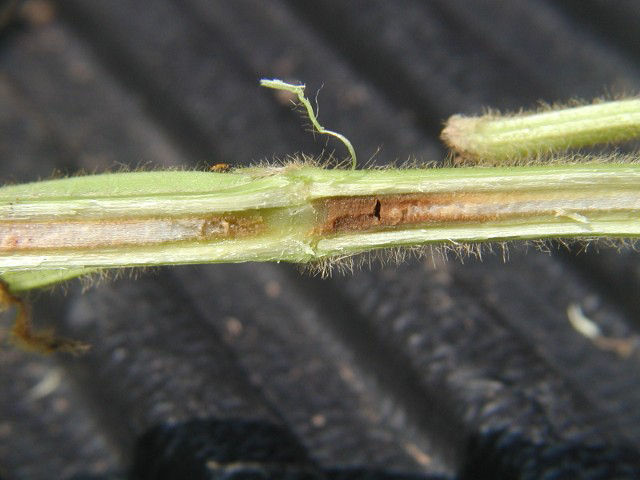
Identification, Characteristics, and Diagnosis:
- Caused by the soilborne fungus Cadophora gregata.
- Foliar symptoms occur when pods begin to fill, about R3 to R4 growth stages, but infection occurs early in the season through the roots.
- Depending on the environment and pathogen genotype, leaf necrosis may occur (genotype A) or may not occur (genotype B), along with vascular browning.
- A pathogen-produced toxin is believed to cause interveinal chlorosis and necrosis.
- Infected leaves remain attached to the plant.
- The pith of longitudinally split stems is a light to dark, chocolate-brown color (Figure 4).
- Favored by cool weather during pod fill and with soil pH less than 6.5.
- BSR foliar symptoms resemble those of sudden death syndrome (SDS) and northern stem canker (NSC). Distinguishing symptoms include a brown pith and no root rot in BSR, a white pith and have root rot in SDS, and reddish-brown cankers near the nodes and no root rot in NSC.
Management:
- Residue management through tillage can help reduce pathogen survivability.
- Crop rotation to non-host crops such as corn or small grains for a minimum of three years can help reduce the fungal population in the soil.
- Plant tolerant soybean products.
Cercospora Leaf Blight
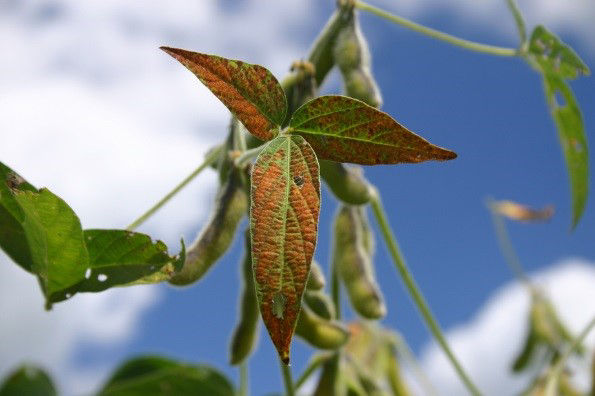
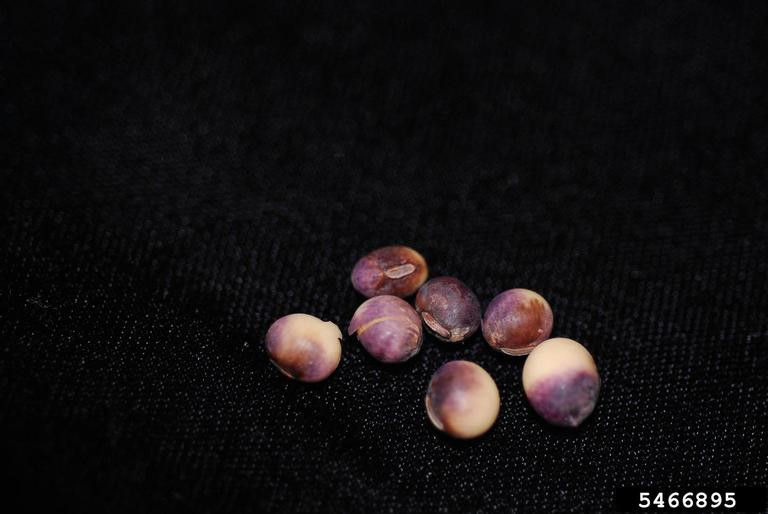
Identification, Characteristics, and Diagnosis:
- Caused by the fungus Cercospora kikuchii.
- Usually noticed during reproductive growth stages.
- Light- to dark-purple areas develop on sun-exposed leaves and eventually cover the entire leaf.
- Leaves become leathery, dark, reddish purple, bronzed, and/or blighted (Figure 5).
- Infected pods may have a purplish discoloration.
- The fungus also causes purple seed stain (Figure 6).
- Overwinters in infested debris and in infected seed.
- Host plants include many weed species such as lambsquarters, pigweed, mallow, and bindweed.
- Favored by extended periods of dew and high relative humidity.
Management:
- Apply Delaro® 325 SC fungicide or Delaro® Complete Fungicide. To learn more about applying these fungicides please visit https://www.cropscience.bayer.us/products/fungicides/delaro or contact your retailer.
- Earlier-maturing soybean products may not be infected.
- Some soybean products have higher tolerance levels.
- Rotate away from soybean crop as soybean is the only main row crop that is a host.
- Residue management through tillage can help reduce pathogen survivability.
Charcoal Rot

Identification, Characteristics, and Diagnosis:
- Caused by the soilborne fungus Macrophomina phaseolina.
- Infection generally occurs within two to three weeks after planting when soils are wet. However, the disease becomes dormant unless hot, dry conditions occur during the growing season.
- During reproductive growth stages, developing leaves may be small, rolled, lose vigor, turn yellow, wilt, die, and remain attached to petioles.
- Infected plants may mature early and develop tiny, black sclerotia that resemble charcoal powder beneath the epidermis on the lower stem, taproot, and pith (Figure 7).
- Black streaks may develop in the woody portion of the crown.
- Lower stems may appear silvery or light gray.
- Favored by high temperatures and light-colored soils under drought conditions. Infected plants may be noted first on field edges and ridges where soil is more prone to drought.
Management:
- Plant soybean products that have higher levels of tolerance.
- Plant early maturing soybean products early to reduce the potential of plants achieving reproductive growth stages during typical high-heat months.
- Plant a non-host crop such as cereal grains for one to two years to help reduce pathogen populations.
- Use conservation tillage and reduce tillage planting methods to conserve soil moisture.
- Maintain fertility.
- Irrigate to help reduce drought stress, if possible and avoid high seeding rates.
- Maintain good weed control to reduce stress.
Downy Mildew

Identification, Characteristics, and Diagnosis:
- Caused by a fungus-like organism, Peronospora manshurica.
- Overwinters in the soil and in infested crop debris.
- Infection occurs in the spring when oospores germinate and infect seedlings.
- Upper surfaces of young leaves develop pale-green to light-yellow spots which enlarge into pale- to bright-yellow lesions (Figure 8).
- White to gray fungal tufts develop on the underside of the lesion.
- Oldest lesions become grayish brown to dark brown with yellowish-green margins.
- Favored by high humidity levels.
Management:
- Plant tolerant soybean products.
- Rotate soybean with a non-bean crop for at least one year.
- Rarely affects yield, so foliar fungicides are not recommended.
- Bury infested residue where feasible.
- Seed treatments can help protect seedlings from initial infection.
Frogeye Leaf Spot
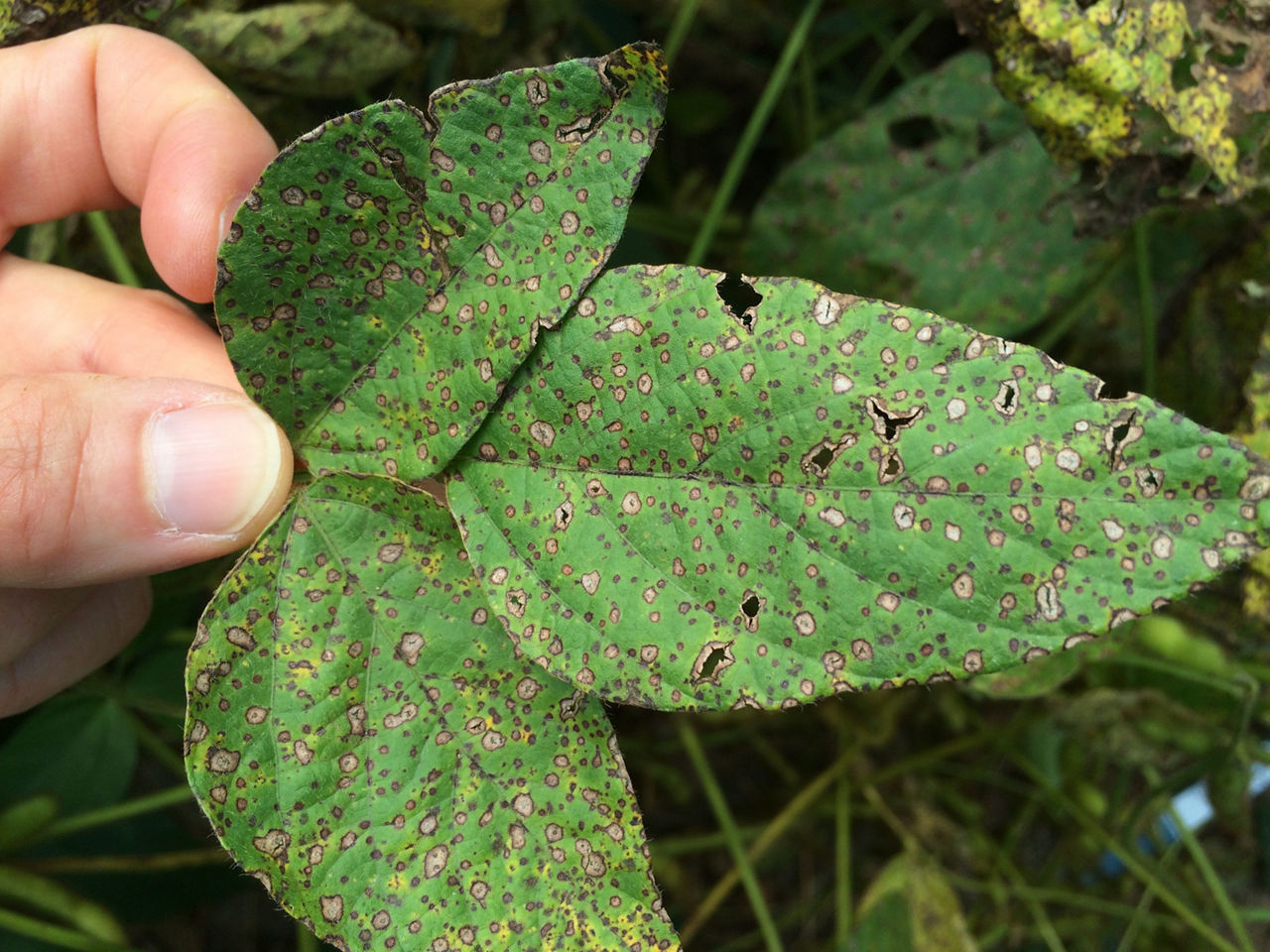
Identification, Characteristics, and Diagnosis:
- Caused by the fungus Cercospora sojina.
- Symptoms initially appear during reproductive growth stages as dark, water-soaked lesions on younger leaves with centers that become ash gray to light brown.
- Later, the lesions become circular to angular with a purple to dark-brown margin around the tan to gray center (Figure 9).
- On leaf undersides, the center of the lesions may have a dark black area where spores are being produced.
- Favored by warm 77 to 86 °F temperatures and prolonged periods of dew or light rain.
Management:
- Plant tolerant soybean products.
- Crop rotation to a non-host crop like corn, small grains, or grain sorghum. However, long rotations may be necessary if the disease has been severe.
- Tillage encourages residue decomposition and can help reduce pathogen levels.
- Apply Delaro® 325 SC fungicide or Delaro® Complete Fungicide. To learn more about these fungicides please visit https://www.cropscience.bayer.us/products/fungicides/delaro or contact your retailer.
Northern Stem Canker (NSC)
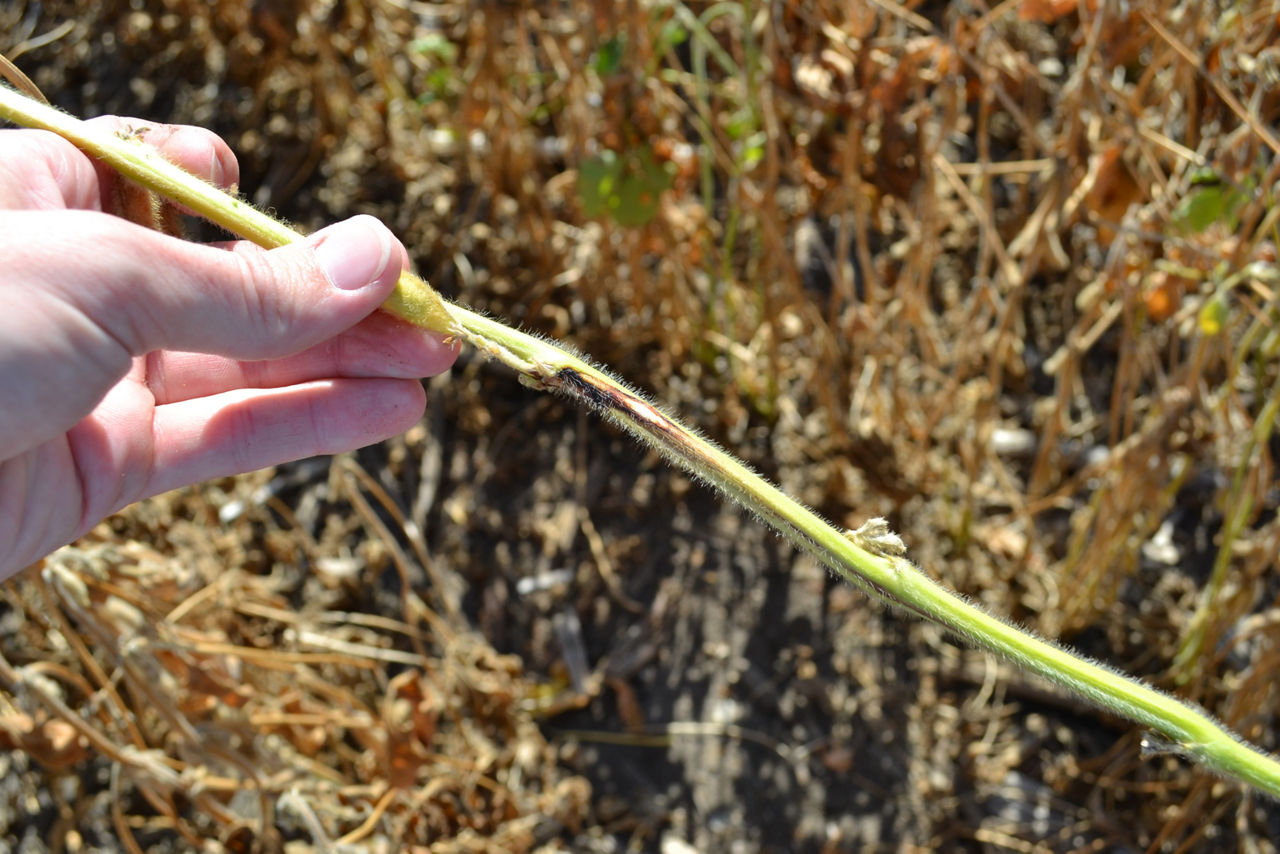
Identification, Characteristics, and Diagnosis:
- Caused by the fungus Diaporthe phaseolorum var. caulivora.
- Initial infection can occur around the V3 growth stage, at which point seedlings can die quickly or survive and develop stem symptoms during pod set.
- Symptoms during reproductive growth stages appear as small, reddish-brown spots on stems near a node within the canopy (Figure 10).
- Spots develop into one- to three-inch-long cankers running up the stem from the point of infection.
- Cankers can girdle the plant causing plant death from interrupted nutrient and water flow.
- On dead plants, the cankers are hard to distinguish from non-infected stem tissue. Plant death can occur from a fungal toxin.
- Foliar symptoms appear during reproductive growth stages as yellowing between the veins, usually on one side of the leaf.
- Leaves turn brown, die, and remain attached to the stem.
- The pith of dead plants is light brown and stems can easily snap because of brittleness.
- Favored by cooler temperatures and extended periods of rain occurring early in the growing season.
- Foliar symptoms of NSC resemble those of sudden death syndrome (SDS). Distinguishing symptoms include white pith and root rot in SDS.
Management:
- Plant tolerant soybean products.
- Rotate to a non-host crop such as wheat and corn for two years to reduce pathogen populations.
- Use tillage to help destroy infested residue.
- Applying a labeled fungicide at or before V3 infection may help protect plants.
Septoria Brown Spot

Identification, Characteristics, and Diagnosis:
- Caused by the fungus Septoria glycines.
- Irregular, dark brown lesions or spots that often have a surrounding yellow halo develop on lower plant leaves (Figure 11).
- Lesions can be small specks to 1/5 inch in diameter and coalesce to form larger spots.
- Defoliation can occur.
- Favored by wet weather and temperatures ranging from 79 to 83°F.
Management:
- Foliar fungicides applications are rarely justified; however, it may be economically justified if conditions are extremely favorable, and the disease develops in the upper canopy. Delaro® 325 SC fungicide or Delaro® Complete Fungicide are options. To learn more about applying these fungicides please visit https://www.cropscience.bayer.us/products/fungicides/delaro or contact your retailer.
- Rotation with non-legume crops and tillage may be beneficial (avoid continuous soybean crops).
- If possible, improve field drainage.
- Planting later may reduce the potential for a saturated environment.
Soybean Rust
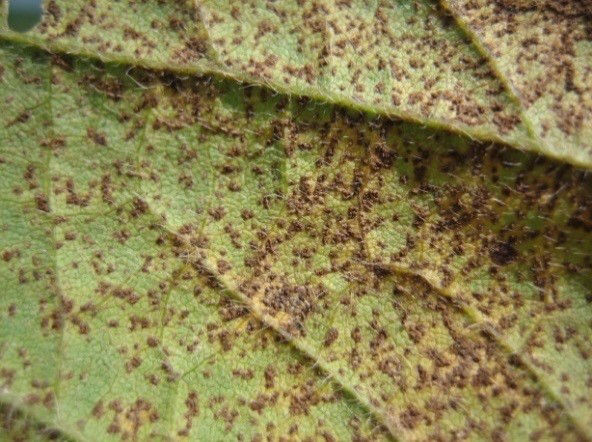
Identification, Characteristics, and Diagnosis:
- Caused by the fungus Phakopsora pachyrhizi.
- Does not overwinter in most Midwestern areas. Spores are carried by wind currents from southern locations into the Midwest.
- Initial infection may appear as small, brown or brick-red dots on the upper leaf surface (Figure 12).
- Later, raised pustules (viewable with a 30X lens) resembling small volcanoes develop in angular lesions on the underside of leaves in the center and lower canopy. The pustules release spores through a central opening.
- Optimum conditions for infection include a minimum of six hours of leaf wetness (10-to-12-hour periods are considered very favorable) and temperatures ranging from 70 to 80 °F, though infection can occur at temperatures as low as 59 °F.
Management:
- If local sentinel plots indicate the presence of soybean rust, scouting should be diligent and thorough, particularly in early planted fields, early maturing soybean products, low-lying fields, fields with prolonged wetness, and fields with early canopy closure.
- Apply Delaro® 325 SC fungicide or Delaro® Complete Fungicide. To learn more about these fungicides please visit https://www.cropscience.bayer.us/products/fungicides/delaro or contact your retailer.
Sudden Death Syndrome (SDS)
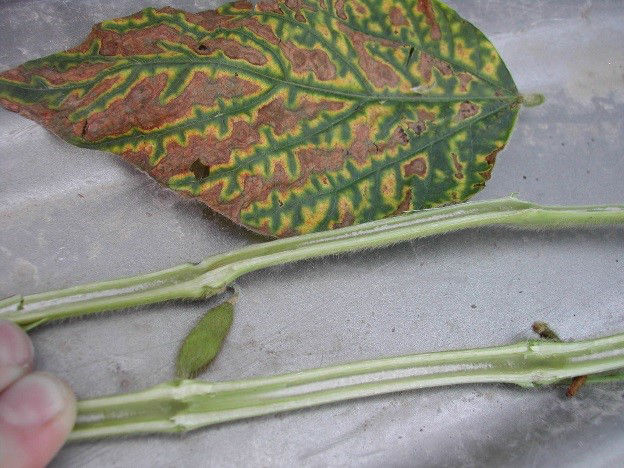
Identification, Characteristics, and Diagnosis:
- Caused by the soilborne fungus Fusarium virguliforme.
- Initial visual symptoms appear as small, yellow spots on leaves during reproductive growth stages, though infection usually occurs at the seedling stage.
- The spots progress to interveinal chlorosis (yellowing) and eventually the leaf tissue dies (Figure 13).
- Leaves may fall prematurely, leaving petioles attached.
- The foliar symptoms are almost identical to those associated with brown stem rot.
- Roots are rotted, pith tissue remains white (Figure 13), and xylem (cortical tissue) is gray to brown. Under some conditions, a light blue spore mass may form on the tap root.
- More severe in the presence of soybean cyst nematode (SCN) and in low, wet field areas.
- Favored by cool, wet conditions and may be worse following corn as the pathogen also causes stalk rot.
- SDS foliar symptoms resemble northern stem canker (NSC). Distinguishing symptoms of the diseases include a white pith and root rot in SDS and no root rot in NSC.
Management:
- Plant soybean products with higher tolerance ratings. Earlier-maturing products may have a lower potential for infection.
- Utilize soybean seed treatments such as ILEVO® seed treatment.
- Delay planting until soil conditions are drier and warmer.
- Improve field drainage, reduce soil compaction, and manage SCN.
Target Leaf Spot
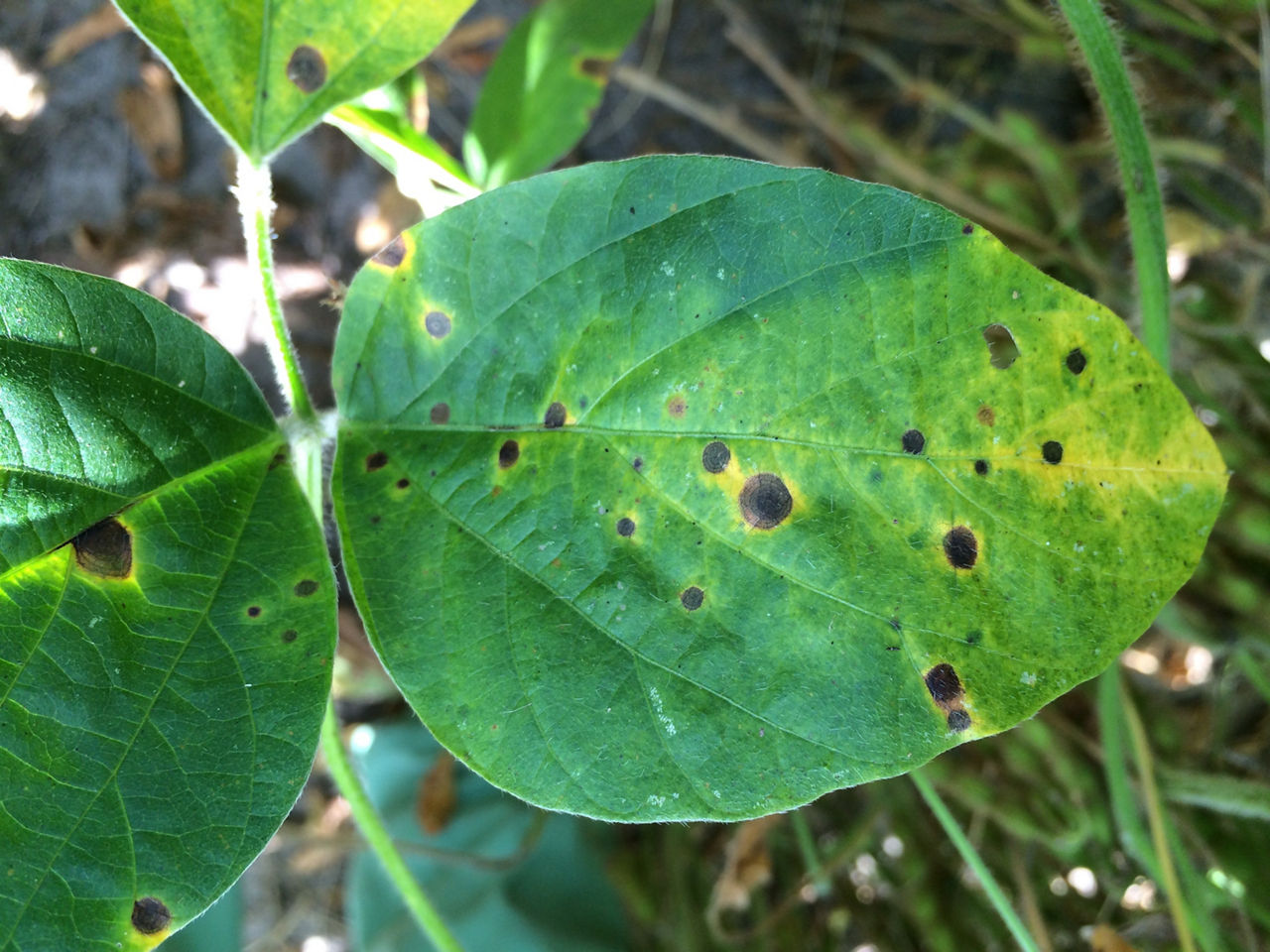
Identification, Characteristics, and Diagnosis:
- Caused by the fungus Corynespora cassiicola.
- Lower leaves develop small, brown specks (spots) that are round to irregular with a possible yellow halo.
- Mature spots may be 3/8 to 5/8 inches or more in diameter.
- Some spots may have a zonate (ringed or belted) appearance (Figure 14).
- Areas of infection on stems and petioles are dark brown and range from specks to elongated lesions.
- Lesions developing on pods are circular, usually as small as 1/32 of an inch, and purple or black with brown margins.
- Favored by high humidity (greater than 80%) or free moisture and cool to moderate soil temperatures.
- Dry conditions help suppress the disease.
Management:
- Plant tolerant soybean products.
- Reduce surface residue through tillage.
- If possible, avoid planting back-to-back soybean crops.
- Fungicides are not recommended because target leaf spot has a low potential for yield reduction.
White Mold
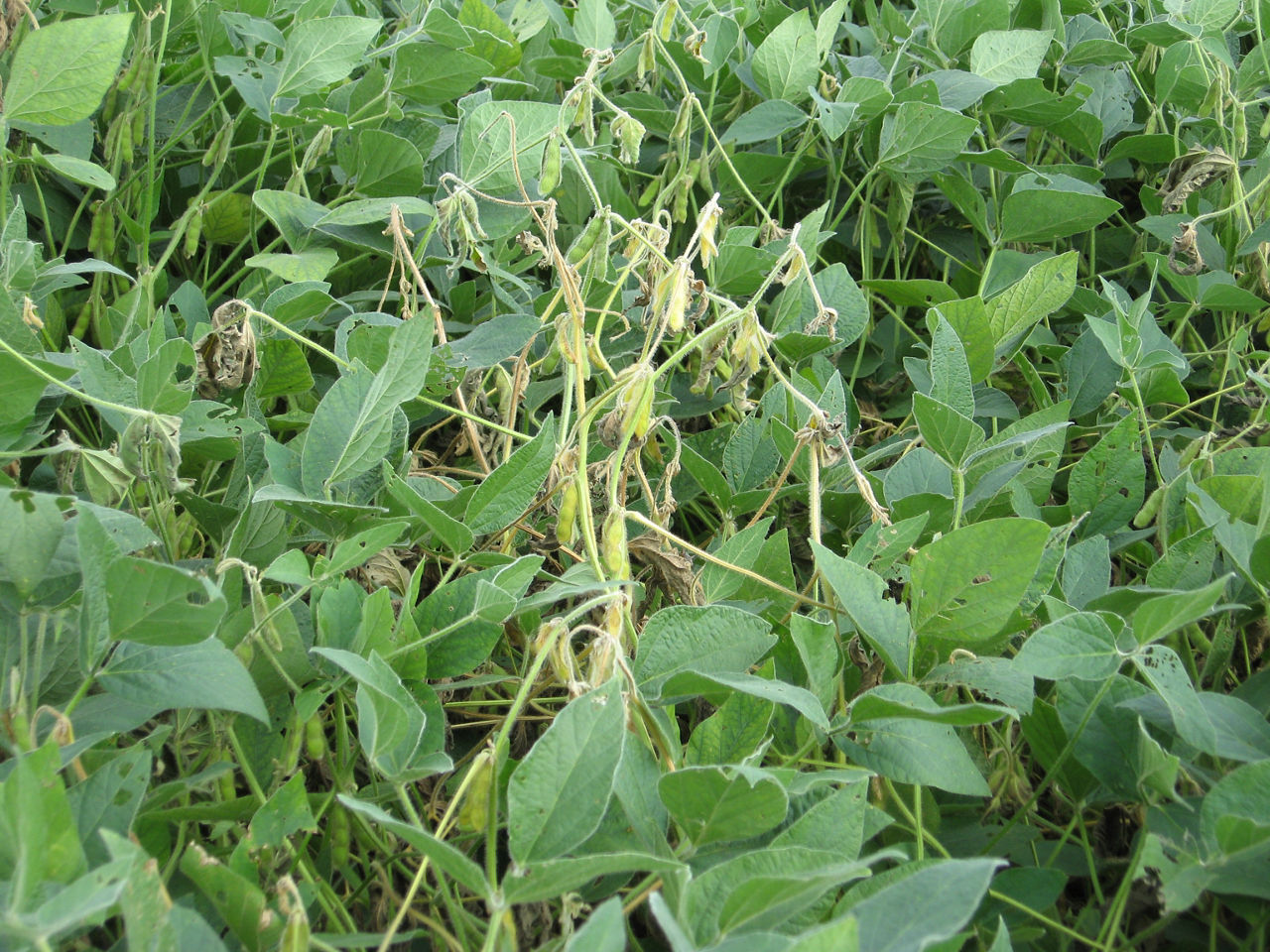
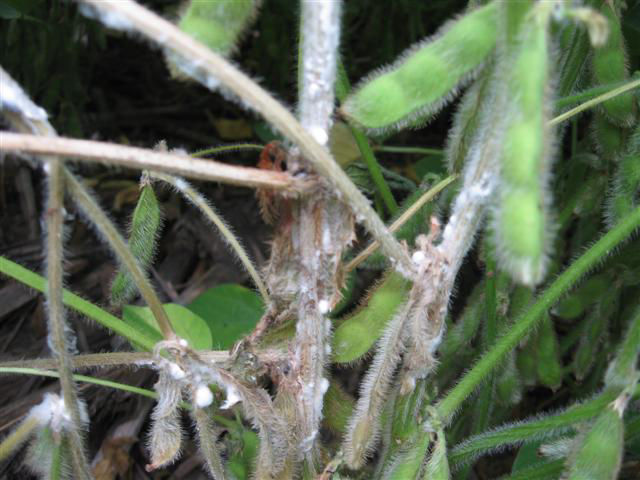
Identification, Characteristics, and Diagnosis:
- Caused by the fungus Sclerotinia sclerotiorum.
- Germinating sclerotia (small, hard, black fruiting structures) near the soil surface produce small, tan to gray mushroom-shaped structures that produce spores which spread by wind and infect dead soybean flowers.
- Lesions develop at stem nodes during or after flowering.
- Lesions become larger (3 to 18 inches long), and the tops of plants turn grayish green, wilt, and die (Figure 15).
- Stems become soft, watery, and covered with white mold (Figure 16).
- Dry, dead stems may have a bleached, white appearance.
- Hard, black fungal fruiting bodies (sclerotia) are produced on or inside stems and pods.
- Dead plants remain upright and may be scattered or in patches throughout an infected field.
- Favored by moist soils, rainy weather, high relative humidity, cool (less than 85 °F). conditions during flowering, reduced air circulation in fields with high populations and narrow rows, high fertility, and possibly earlier planting.
Management:
- Plant disease-free seed.
- Select soybean products that may have some level of tolerance. Consider reducing seeding rates and utilize wider rows.
- If irrigating, reduce the frequency during flowering.
- Sclerotia can remain viable for several years in the soil, so long-term rotations to corn or other non-host crops may help reduce the potential for infection.
- Consider implementing biological controls such as Contans® WG.
Viral Diseases
Bean Pod Mottle Virus (BPMV)
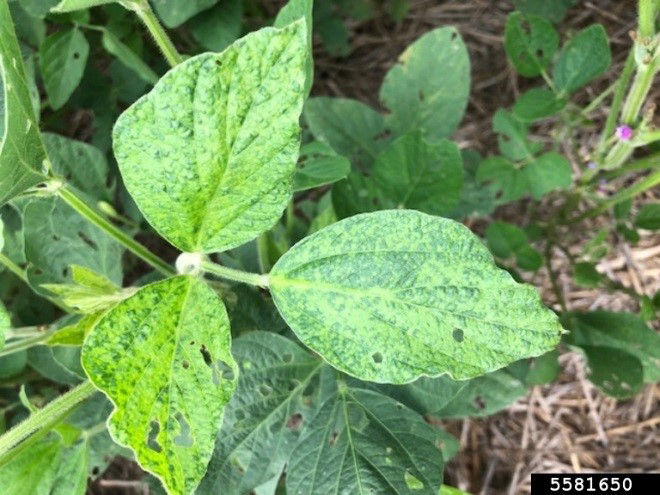
Identification, Characteristics, and Diagnosis:
- Vectored by the bean leaf beetle, Cerotoma trifurcate Förster.
- Foliar symptoms range from mild chlorotic mottling on upper leaves to puckering and severe mosaic on lower leaves (Figure 17).
- Delayed maturity or green stems are often observed near harvest.
- Seed coat mottling may be present.
- The virus overwinters in bean leaf beetles and can infect seedlings as the beetles feed.
- The virus can also overwinter in perennial weeds and infected seed.
- Plant infection by BPMV and soybean mosaic virus (SMV), which is vectored by soybean aphid, may cause severe dwarfing, foliar distortion, leaf necrosis, leaf mottling, and severe yield loss.
Management:
- Managing emerging and first-generation bean leaf beetles in the spring with timely and labeled insecticides can reduce populations of the virus-laden insects.
- Controlling alternative BPMV hosts such as cowpea (Vigna unguiculate), other bean species, and Demodium species can help reduce the inoculum source.
- Delayed planting may increase early-season death of bean leaf beetles, reducing the vectoring population.
Soybean Mosaic Virus (SMV)
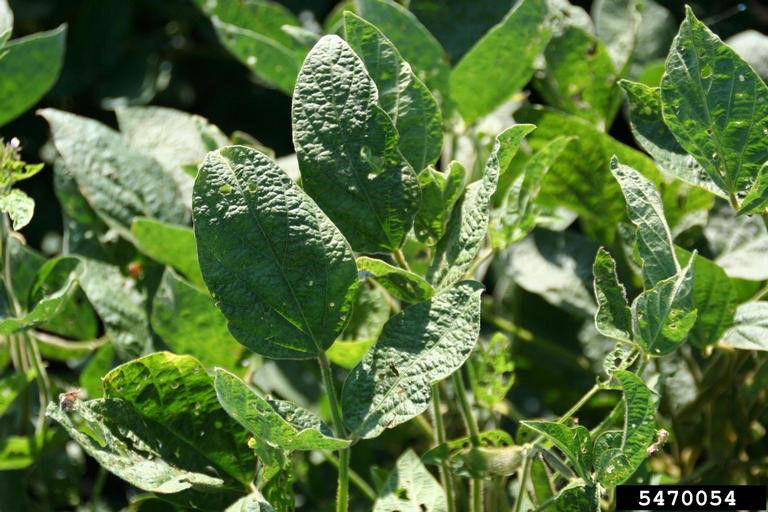
Identification, Characteristics, and Diagnosis:
- Aphids are a primary vector.
- A green/yellow mosaic pattern is the most common initial symptom on leaves (Figure 18).
- More mature leaves may exhibit a yellow/brown mosaic pattern.
- Premature defoliation is common.
- Infected seeds exhibit a brown or black mottling.
- Spreads from plant to plant by soybean aphid feeding.
- Plant infection by SMV and bean pod mottle virus (BPMV), vectored by bean leaf beetles, may cause severe dwarfing, foliar distortion, leaf necrosis, leaf mottling, and yield loss.
Management:
- Seeds should be virus-free.
- Plant tolerant soybean products.
- Early planting may minimize aphid transmission at an early crop growth stage.
- Insecticide applications are not recommended because some insecticides may increase soybean aphid movement in the field, increasing the dissemination of the virus.
Soybean Vein Necrosis Virus (SVNV)
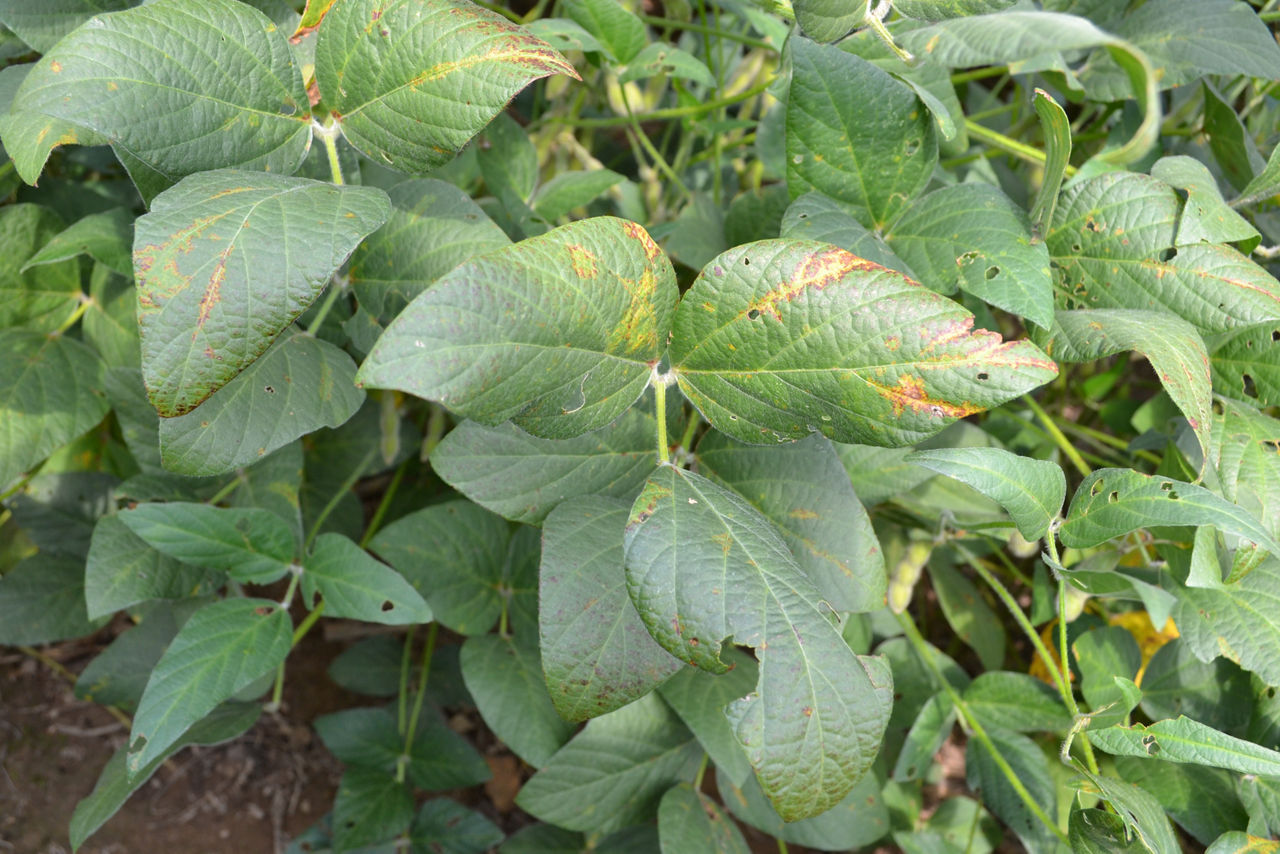
Identification, Characteristics, and Diagnosis:
- Vectored by soybean thrips, Neohydatothrips variablilis Beach.
- Can also be transmitted by seed.
- Virus infection can occur throughout the growing season, but symptoms are most visible around mid-June after flowering.
- Initial symptoms appear as thread-shaped vein clearing along the main leaf veins.
- Severe infections may result in purple to dark-brown lesions across most of the leaf (Figure 19).
- Veins become yellow and necrotic as the growing season progresses.
- Several areas on a leaf may have lesions.
- Early lesions lack defined edges.
- Highest canopy leaves are most affected because emerging leaves are prime feeding sites for soybean thrips.
- Favored by cool temperatures and mild winters followed by a warm spring, which may help increase the thrips population.
Management:
- Control soybean thrips with timely and labeled insecticides.
- Controlling alternate virus hosts such as ivyleaf morningglory (Ipomoea hederacea Jacq), cowpea (Vigna unguiculate), and mung bean (Vigna radiata) can help reduce the inoculum source.
Soybean Nematodes
Soybean Cyst Nematode (SCN)

Identification, Characteristics, and Diagnosis:
- Heterodera glycines.
- More common in sandy soils, though SCN is well distributed throughout most soil types.
- Penetrates roots to feed.
- Evidence of feeding may be unnoticed until plants are under stress.
- Common symptoms include yellowish leaves and stunting.
- Nitrogen-fixing nodule formation can be reduced.
- Feeding wounds can be entry points for other diseases.
- Female cysts (initially white) that contain up to 500 eggs develop on roots. As cysts mature, their color changes from white, to yellow, to brown. Brown cysts have died and become the overwintering stage.
- Hot weather can reduce reproduction while cool to moderate weather can increase reproduction.
- Genetic variance occurring within SCN populations creates distinct and different HG-types (Heterodera glycines-types).
Management:
- Utilizing tolerant soybean varieties is the best and most effective management tool to control SCN. There are two types of tolerance for SCN currently available in the seed industry. Peking and PI 88788-type sources of tolerance are the most widely used.
- Utilize an in-furrow or seed treatment nematicide such as ILEVO® seed treatment.
- Rotate to a non-legume crop such as alfalfa, canola, corn, cotton, sorghum, or wheat.
- Manage weedy hosts such as purple deadnettle, henbit, field pennycress, shepherd’s-purse, common chickweed, smallflowered bittercress, common mallow, white clover, Canada thistle, common cocklebur, and others.
- Maintain adequate fertility.
- Soil sample in the fall to determine the SCN population and race(s).
Northern Root-knot Nematode
Identification, Characteristics, and Diagnosis:
- Northern root-knot (M. hapla)
- Non-uniform stunting, wilting, chlorotic patches, and possible root galls.
- Most common in sandy soils.
- Eggs can survive in soil for several years until favorable conditions for hatching exist.
- Lab analysis may be required to distinguish which species is present.
Management
- Plant tolerant soybean products.
- Utilize an in-furrow or seed treatment nematicide.
- Rotate to corn or small grains crops (most all other major agronomic are susceptible).
- Sanitize equipment when moving from field to field.
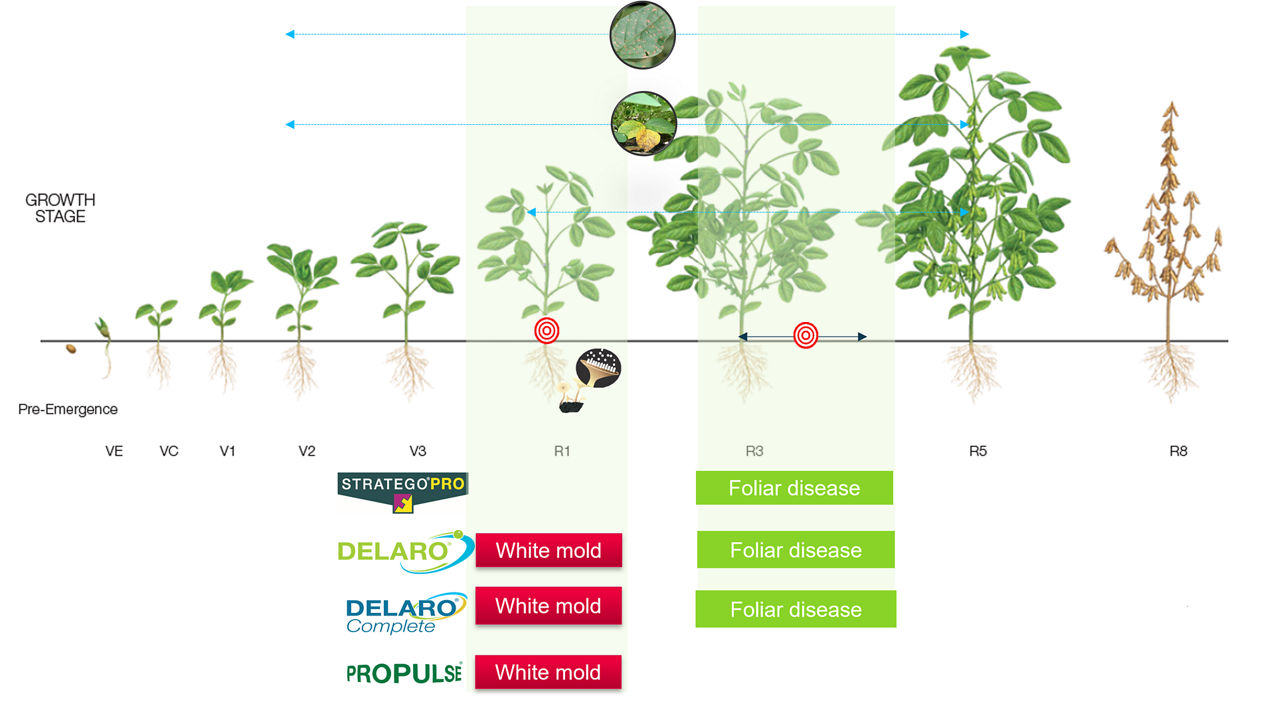
Sources:
Markell, S. and Malvick, D. 2021. Soybean disease diagnostic series. North Dakota State University. PP1867, https://www.ndsu.edu/agriculture/ag-hub/publications/soybean-disease-diagnostic-series.
Brown, C., Follings, J., Moran, M., and Rosser, B. (Eds.) 2022. Agronomy guide for field crops. Publication 811E. Ontario Ministry of Agriculture, Food, and Rural Affairs. https://www.ontario.ca/page/agronomy-guide-field-crops#section-1.
Warner, F. 2006. Nematodes attacking soybeans. Michigan State University. MSU Diagnostic Services https://www.canr.msu.edu/news/nematodes_attacking_soybeans.
Web sources verified 07/27/23. 1311_129254
Seed Brands & Traits
Crop Protection
Disclaimers
- always read and follow pesticide label directions, insect resistance management requirements (where applicable), and grain marketing and all other stewardship practices. to review additional important information, click to open the menu below.expand_more
No dicamba may be used in-crop with seed with Roundup Ready® Xtend Technology, unless and until approved or specifically permitted, and no dicamba formulations are currently registered for such use in the 2024 season. Please follow www.roundupreadyxtend.com/xtendimaxupdates for status updates
Based on Court ruling and EPA Existing Stocks Order* on XtendiMax® Herbicide registration, Bayer has stopped its sale and distribution of XtendiMax® Herbicide. Visit our XtendiMax herbicide updates page to learn the latest www.roundupreadyxtend.com/xtendimaxupdates.
*Low-volatility dicamba products subject to the ruling include XtendiMax® herbicide with VaporGrip® Technology, Engenia® herbicide and Tavium® Plus VaporGrip® Technology herbicide.
The Preceon™ Smart Corn System, including short stature corn developed through traditional breeding, is expected to be available, subject to final commercialization decisions, for planting in the 2024 growing season.
Short stature corn developed through biotechnology is not currently available for commercial sale or commercial planting. Commercialization is dependent on multiple factors, including successful conclusion of the regulatory process.
This material may contain “forward-looking statements” based on current assumptions and forecasts made by Bayer management. Various known and unknown risks, uncertainties and other factors could lead to material differences between the actual future results, financial situation, development or performance of the company and the estimates given here. These factors include those discussed in Bayer’s public reports which are available on the Bayer website at www.bayer.com. The company assumes no liability whatsoever to update these forward-looking statements or to conform them to future events or developments.
*Commercialization is dependent on multiple factors, including successful conclusion of the regulatory process. The information presented herein is provided for educational purposes only, and is not and shall not be construed as an offer to sell, or a recommendation to use, any unregistered pesticide for any purpose whatsoever. It is a violation of federal law to promote or offer to sell an unregistered pesticide.
Bayer is a member of Excellence Through Stewardship® (ETS). Bayer products are commercialized in accordance with ETS Product Launch Stewardship Guidance, and in compliance with Bayer’s Policy for Commercialization of Biotechnology-Derived Plant Products in Commodity Crops. Commercialized products have been approved for import into key export markets with functioning regulatory systems. Any crop or material produced from this product can only be exported to, or used, processed or sold in countries where all necessary regulatory approvals have been granted. It is a violation of national and international law to move material containing biotech traits across boundaries into nations where import is not permitted. Growers should talk to their grain handler or product purchaser to confirm their buying position for this product. Excellence Through Stewardship® is a registered trademark of Excellence Through Stewardship.
XtendiMax® herbicide with VaporGrip® Technology has been classified as pesticide and must be used with VaporGrip® Xtra Agent (or an equivalent volatility reduction adjuvant). For approved tank-mix products (including VRAs and DRAs), nozzles and other important label information visit XtendiMaxApplicationRequirements.com. Applicators must check XtendiMaxApplicationRequirements.com no more than 7 days before application of this product for additional labeling, including state restrictions. Where applicable, users must comply with additional requirements found on this website.
ALWAYS READ AND FOLLOW PESTICIDE LABEL DIRECTIONS. Not all products are registered for use in all states and may be subject to use restrictions. The distribution, sale, or use of an unregistered pesticide is a violation of federal and/or state law and is strictly prohibited. Check with your local dealer or representative for the product registration status in your state.
Product Use Statement: Enlist E3® soybeans contain the Enlist E3 trait that provides crop safety for use of labeled over-the-top applications of glyphosate, glufosinate and 2,4-D herbicides featuring Colex-D® technology when applied according to label directions. Following burndown, the only 2,4-D containing herbicide products that may be used with Enlist® crops are products that feature Colex-D technology and are expressly labeled for use on Enlist crops. 2,4-D products that do not contain Colex-D technology are not authorized for use in conjunction with Enlist E3 soybeans. Warning: Enlist E3 soybeans are tolerant of over-the top applications of glyphosate, glufosinate, and 2,4-D. Accidental application of incompatible herbicides to this variety could result in total crop loss. When using 2,4-D herbicides, grower agrees to only use 2,4-D products that contain Colex-D technology authorized for use in conjunction with Enlist E3 soybeans. Always read and follow herbicide label directions prior to use.
YOU MUST SIGN A TECHNOLOGY AGREEMENT, READ THE PRODUCT USE GUIDE PRIOR TO PLANTING AND FOLLOW HERBICIDE RESISTANCE MANAGEMENT (HRM) REQUIREMENTS.
The transgenic soybean event in the Enlist E3® soybeans is jointly developed and owned by Corteva Agriscience and M.S. Technologies, L.L.C. ®™ Enlist, Enlist E3, the Enlist E3 logo and Colex-D are trademarks Corteva Agriscience and its affiliate companies.
Alloy™ and Connect™ are trademarks of M.S. Technologies, L.L.C., West Point, IA. Please read the M.S. Technologies, L.L.C. Use Restriction Agreement located at: - http://www.mstechseed.com/use-restriction-agreement/.
ALWAYS READ AND FOLLOW PESTICIDE LABEL DIRECTIONS. FOR COTTON TREATED FOR MARKET YEAR 2024, EACH ACCELERON® SEED APPLIED SOLUTIONS OFFERING is a combination of separate individually registered products containing the active ingredients: BASIC Offering: fluoxastrobin, prothioconazole, metalaxyl, myclobutanil, and penflufen. STANDARD Offering: fluoxastrobin, prothioconazole, metalaxyl, myclobutanil, penflufen, and imidacloprid. ELITE plus Copeo® Offering: fluoxastrobin, prothioconazole, metalaxyl, myclobutanil, penflufen, imidacloprid, and fluropyram.
FOR COTTON TREATED FOR MARKET YEAR 2022 OR PRIOR, EACH ACCELERON® SEED APPLIED SOLUTIONS OFFERING is a combination of separate individually registered products containing the active ingredients: BASIC Offering: fluxapyroxad, pyraclostrobin, metalaxyl, and myclobutanil. STANDARD Offering: fluxapyroxad, pyraclostrobin, metalaxyl, myclobutanil, and imidacloprid. ELITE plus Poncho®/VOTiVO® Offering: fluxapyroxad, pyraclostrobin, metalaxyl, myclobutanil, imidacloprid, clothianidin, and Bacillus Firmus I-1582.
Please review each seed tag to determine active ingredients in the product offering on the seed. The distribution, sale, or use of an unregistered pesticide is a violation of federal and/or state law and is strictly prohibited. Not all products are approved in all states.
ALWAYS READ AND FOLLOW PESTICIDE LABEL DIRECTIONS. FOR SOYBEANS SEED TREATMENT PRODUCTS APPLIED DOWNSTREAM, EACH ACCELERON® SEED APPLIED SOLUTIONS OFFERING is a combination of separate individually registered products containing the active ingredients: BASIC Offering: metalaxyl, penflufen and prothioconazole. STANDARD Offering: metalaxyl, penflufen, prothioconazol and imidacloprid. FOR UPSTREAM TREATED SOYBEANS, EACH ACCELERON® SEED APPLIED SOLUTIONS OFFERINGis a combination of separate individually registered products containing the active ingredients: BASIC Offering: metalaxyl, fluxapyroxad, and pyraclostrobin. STANDARD Offering: metalaxyl, fluxapyroxad, pyraclostrobin and imidacloprid. The distribution, sale, or use of an unregistered pesticide is a violation of federal and/or state law and is strictly prohibited. Not all products are approved in all states.
ALWAYS READ AND FOLLOW PESTICIDE LABEL DIRECTIONS. FOR CORN, EACH ACCELERON® SEED APPLIED SOLUTIONS OFFERING is a combination of separate individually registered products containing the active ingredients: BASIC plus Poncho®/VOTiVO® Offering for corn: metalaxyl, ethaboxam, prothioconazole, fluoxastrobin, clothianidin, Bacillus firmus I-1582. ELITE plus Poncho®/VOTiVO® Offering for corn: metalaxyl, ethaboxam, clothianidin, and Bacillus firmus I-1582; prothioconazole and fluoxastrobin at rates that suppress additional diseases. BASIC Offering for corn: metalaxyl, prothioconazole, fluoxastrobin, ethaboxam, and clothianidin. ELITE Offering for corn: metalaxyl, ethaboxam, and clothianidin; and prothioconazole and fluoxastrobin at rates that suppress additional diseases. BioRise® Corn Offering is included seamlessly across offerings on all class of 2017 and newer products. The distribution, sale, or use of an unregistered pesticide is a violation of federal and/or state law and is strictly prohibited. Not all products are approved in all states.
Performance may vary, from location to location and from year to year, as local growing, soil and weather conditions may vary. Growers should evaluate data from multiple locations and years whenever possible and should consider the impacts of these conditions on the grower’s fields.
The Bayer Carbon Program described in this material is subject to the current version of the Bayer Carbon-Smart Practices Master Agreement. The information is to aid in the understanding of the Bayer Carbon Program and does not change or modify the Bayer Carbon-Smart Practices Master Agreement in any way.
The RRXtend Spray App provides forecasts for locations within the contiguous United States. Do not use this app for forecasts outside the contiguous United States. Forecasts are for planning purposes only and are not a substitute for checking actual weather conditions at your location at the time of application and comply with the product label and other legal requirements.
B.t. products may not yet be registered in all states. Check with your seed brand representative for the registration status in your state.
Refuge seed may not always contain the DroughtGard® trait. Adament™ 50 WG Fungicide is only registered in California. Roundup Technology® includes glyphosate-based herbicide technologies.
IMPORTANT IRM INFORMATION: Certain products are sold as RIB Complete® corn blend products, and do not require the planting of a structured refuge except in the Cotton-Growing Area where corn earworm is a significant pest. Products sold without refuge in the bag (non-RIB Complete) require the planting of a structured refuge. See the IRM/Grower Guide for additional information. Always read and follow IRM requirements.
ONLY USE FORMULATIONS THAT ARE SPECIFICALLY LABELED FOR SUCH USES AND APPROVED FOR SUCH USE IN THE STATE OF APPLICATION. Contact the U.S. EPA and your state pesticide regulatory agency with any questions about the approval status of dicamba herbicide products for in-crop use with products with XtendFlex® Technology.
ALWAYS READ AND FOLLOW PESTICIDE LABEL DIRECTIONS. It is a violation of federal and state law to use any pesticide product other than in accordance with its labeling. NOT ALL formulations of dicamba or glyphosate are approved for in-crop use with Roundup Ready 2 Xtend® soybeans. NOT ALL formulations of dicamba, glyphosate or glufosinate are approved for in-crop use with products with XtendFlex® Technology.
Roundup Ready® Technology contains genes that confer tolerance to glyphosate. Roundup Ready® 2 Technology contains genes that confer tolerance to glyphosate. LibertyLink® Technology contains genes that confer tolerance to glufosinate. Roundup Ready® Flex Technology contains genes that confer tolerance to glyphosate. Roundup Ready technology contains genes that confer tolerance to glyphosate, an active ingredient in Roundup® brand agricultural herbicides. Roundup Ready 2 Xtend® soybeans contain genes that confer tolerance to glyphosate and dicamba. Products with XtendFlex® Technology contains genes that confer tolerance to glyphosate, glufosinate and dicamba. Plants that are not tolerant to glyphosate, dicamba, and/or glufosinate may be damaged or killed if exposed to those herbicides. Contact your seed brand dealer or refer to the Bayer Technology Use Guide for recommended weed control programs.
Insect control technology provided by Vip3A is utilized under license from Syngenta Crop Protection AG. Movento® MPC Insecticide is only registered for use in Florida, Georgia and Alabama. Aeris®, Balance® Flexx, Baythroid® XL, Corvus®, Degree Xtra®, Harness® Xtra 5.6L Herbicide, Harness® Xtra Herbicide, Huskie® Complete, Leverage® 360, and TriVolt™ are restricted use pesticides. Not all products are registered for use in all states and may be subject to use restrictions. The distribution, sale, or use of an unregistered pesticide is a violation of federal and/or state law and is strictly prohibited. Check with your local dealer or representative for the product registration status in your state. Fortenza Advanced™ is an on-seed application of Fortenza® and Rascendo® seed treatments. Agrisure Viptera®, Fortenza Advanced™, Fortenza® and Rascendo® are trademarks of Syngenta Group Company. Tank mixtures: The applicable labeling for each product must be in the possession of the user at the time of application. Follow applicable use instructions, including application rates, precautions and restrictions of each product used in the tank mixture. Not all tank mix product formulations have been tested for compatibility or performance other than specifically listed by brand name. Always predetermine the compatibility of tank mixtures by mixing small proportional quantities in advance. Degree® is a registered trademark of Monsanto Technology LLC. Channel®, Channel® and the Arrow Design® and Seedsmanship At Work® are registered trademarks of Channel Bio, LLC. Services and products offered by Climate LLC are subject to the customer agreeing to our Terms of Service. Our services provide estimates or recommendations based on models. These do not guarantee results. Consult with your agronomist, commodity broker, or other industry professional before making financial, farming, or risk management decisions. More information at www.climate.com/legal/disclaimer. FieldView™ is a trademark of Climate LLC. Herculex® is a registered trademark of Dow AgroSciences LLC. Clearfield®, Copeo®, ILeVO®, LibertyLink logo® , LibertyLink®, Poncho®, Poncho®/Votivo® and Votivo® are trademarks of BASF Corporation. Respect the Refuge and Corn Design® and Respect the Refuge® are registered trademarks of National Corn Growers Association. Some of the product(s) discussed herein are restricted use pesticide(s) and may not be registered in all states. The distribution, sale, or use of an unregistered pesticide is a violation of federal and/or state law and is strictly prohibited. Check with your local dealer or product representative for the product registration status in your state. Absolute®, Acceleron®, Adament™, Admire®, Aeris®, Aliette®, Alion®, Allegiance®, Asgrow and the A Design®, Asgrow®, Autumn™, Axiom®, Balance®, Bayer, Bayer Cross, Baythroid®, BioRise®, Bollgard II®, Bollgard®, BUTEO™ start, Capreno®, ConnectIN™, Corn States Triangle Design®, Corvus®, Degree Xtra®, DEKALB and Design®, DEKALB®, Delaro®, Deltapine Select™, Deltapine®, DiFlexx®, Disease Shield®, DroughtGard®, DryTough™, Emesto®, Evergol®, EverGol®, FarmFlex®, Finish®, Flint®, Fontanelle Hybrids and Design®, Fontanelle Hybrids®, Gaucho®, Gem®, Ginstar®, Gold Country Seed®, Ground Breakers®, H Hubner and Design™, Harness®, Hubner Seed & Design®, Hubner Seed Your Trustworthy Seed Resource & Design®, Hubner Seed™, Huskie®, Jung Seed Genetics & Design®, Jung Seed Genetics™, Kruger Seeds™, Laudis® , Leaf Triangle Design®, Leverage®, Lewis Hybrids and Design®, Lewis Hybrids™ , Lewis Premium Grains & Design®, Luna Experience®, Luna Privilege®, Luna Sensation®, Luna Tranquility®, Luna® Flex, Luna® Pro Fungicide, Luxxur®, MILK MAXX SILAGE RESEARCH and Design®, Minuet™, Movento®, Movento® HL, Nortron®, Oberon®, Olympus®, Poncho®, Preceon™, Proline®, Propulse®, Prosaro®, Prosper®, Provost®, Raxil®, REA Hybrids and Design™, Rea Hybrids™ , Respect the Refuge and Cotton Design®, RIB Complete and Design®, RIB Complete®, Ricestar®, Rimfire®, Roundup PowerMAX®, Roundup Ready 2 Technology and Design®, Roundup Ready 2 Xtend®, Roundup Ready 2 Yield®, Roundup Ready®, Roundup Technology®, Roundup WeatherMAX and Design®, Roundup WeatherMAX®, Roundup®, RT 3 Powered by Roundup Technology and Design®, RT 3®, Scala®, Serenade®, Serenade® SOIL fungicide, SilageSmart & Design®, SilageSmart®, Sivanto®, SmartStax®, Specialty and Design®, Specialty Hybrids™, SR and Design®, Stance®, Stewart and Design™, Stewart Seeds™, Stone Seed & Design™, Stone Seed™, Stratego®, ThryvOn™, Trecepta®, Trilex®, TripleFLEX®, TriVolt™, TruFlex™, VaporGrip®, Varro®, Velum®, Vistive®, VT Double PRO®, VT Triple PRO®, VT4PRO™, VT4PRO™ , Warrant®, WestBred and Design®, WestBred®, Wolverine®, XtendFlex®, XtendiMax® and YieldGard VT PRO® are trademarks of Bayer Group. All other trademarks are the property of their respective owners. For additional product information call toll-free 1-866-99-BAYER (1-866-992-2937) or visit our website at www.BayerCropScience.us. Bayer CropScience LP, 800 North Lindbergh Boulevard, St. Louis, MO 63167. ©2024 Bayer Group. All rights reserved.







©2024 Bayer Group. All rights reserved.